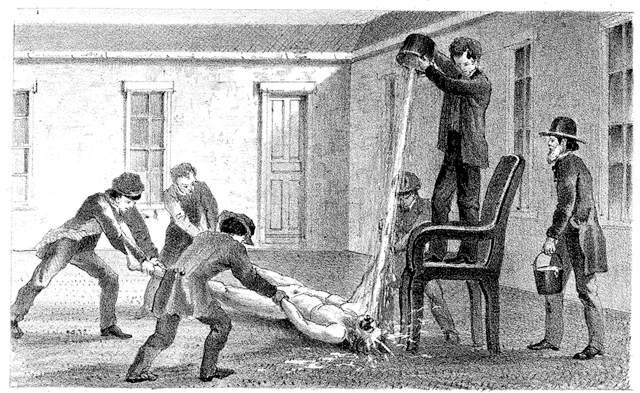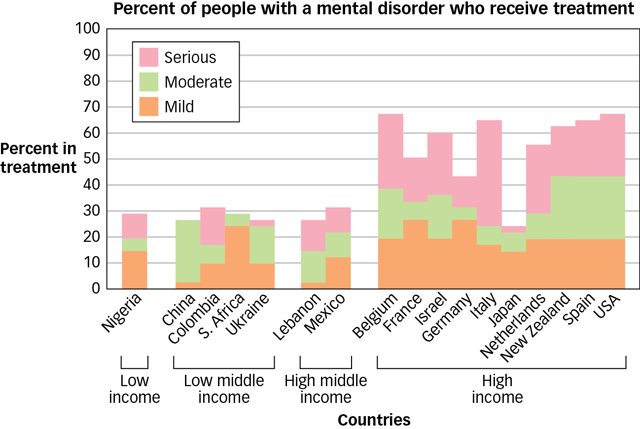16.1 Treatment: Getting Help to Those Who Need It
Estimates suggest that about 1 in every 5 people in Canada suffer from some type of mental disorder at some point in their lifetime (Canadian Mental Health Association, n.d. 1; Kessler, Berglund, et al., 2005). The personal costs of these disorders involve anguish to the sufferers as well as interference in their ability to carry on the activities of daily life. Think about Christine from the example above. If she did not (or could not) seek treatment, she would continue to be crippled by her OCD, which was causing major problems in her life. She had to quit her job at the local coffee shop because she was no longer able to touch money or anything else that had been touched by other people without washing it first. Her relationship with her boyfriend was in trouble because he was growing tired of her constant reassurance seeking regarding cleanliness (hers and his). All of these problems were in turn increasing her anxiety and depression, making her obsessions even stronger. She desperately wanted and needed some way to break out of this vicious cycle. She needed an effective treatment.
What are some of the personal, social, and financial costs of mental illness?
The personal and social burdens associated with mental disorders are also enormous. Mental disorders typically have earlier ages of onset than physical disorders and are associated with significant impairments in the form of an inability to carry out daily activities, such as days out of school or work or problems in family and personal relationships. Impairments associated with mental disorders are as severe, and in many cases more severe, than those associated with physical disorders such as cancer, chronic pain, and heart disease (Ormel et al., 2008). For instance, a person with severe depression may be unable to hold down a job or even get organized enough to collect a disability cheque, and people with many disorders stop getting along with family, caring for their children, or trying to help.
There are financial costs too. In any given week, at least half a million employed people in Canada are unable to work due to mental health problems, and the economic burden for all mental illness is estimated to be $51 billion per year (Centre for Addiction and Mental Health, 2013; Lim et al., 2008; Smetanin et al., 2011). In addition to the personal benefits of treatment, then, society also stands to benefit from the effective treatment of psychological disorders.
Do all people with a mental disorder receive treatment? Not by a long shot. Only about 40 percent of Canadians with mental disorders present themselves for diagnosis and treatment (Lesage et al., 2006). Of those who do seek care, nearly 1 in 3 report that their needs are unmet or only partially met; this is a particular problem for children and youth (Statistics Canada, 2013d). Treatment rates are even lower elsewhere around the world, especially in low-
16.1.1 Why Many People Fail to Seek Treatment
What are the obstacles to treatment for the mentally ill?
A physical symptom such as a toothache would send most people to the dentist—
 When your tooth hurts, you go to a dentist. But how do you know when to see a psychologist?ALLISON LEACH/GETTY IMAGES
When your tooth hurts, you go to a dentist. But how do you know when to see a psychologist?ALLISON LEACH/GETTY IMAGESPeople may not realize that they have a mental disorder that could be effectively treated. Approximately 45 percent of those with a mental disorder who do not seek treatment report that they did not do so because they did not think that they needed to be treated (Mojtabai et al., 2011). Mental disorders are often not taken nearly as seriously as physical illness, perhaps because the origin of mental illness is “hidden” and usually cannot be diagnosed by a blood test or X-
ray. Moreover, although most people know what a toothache is and that it can be successfully treated, far fewer people know when they have a mental disorder and what treatments might be available. There may be barriers to treatment, such as beliefs and circumstances that keep people from getting help. Individuals may believe that they should be able to handle things themselves. In fact, this is the primary reason that people with a mental disorder give for not seeking treatment (72.6 percent) and for dropping out of treatment prematurely (42.2 percent) (Mojtabai et al., 2011). Other attitudinal barriers for not seeking treatment include believing that the problem was not that severe (16.9 percent of nontreatment seekers), the belief that treatment would be ineffective (16.4 percent), and perceived stigma from others (9.1 percent).
Structural barriers prevent people from physically getting to treatment. Like finding a good lawyer or plumber, finding the right psychologist can be more difficult than simply flipping through the telephone directory or searching online. This confusion is understandable given the plethora of different types of treatments available (see The Real World box: Types of Psychotherapists below). Once you find the therapist for you, you may encounter structural barriers related to not being able to afford treatment (15.3 percent of nontreatment seekers), lack of clinician availability (12.8 percent), inconvenience of attending treatment (9.8 percent), and trouble finding transportation to the clinic (5.7 percent) (Mojtabai et al., 2011).
THE REAL WORLD: Types of Psychotherapists
What do you do if you are ready to seek the help of a mental health professional? To whom do you turn? Therapists have widely varying backgrounds and training, and this affects the kinds of services they offer. Before you choose a therapist, it is useful to have an understanding of a therapist’s background, training, and areas of expertise. There are several major “flavours.”
● Psychologist A psychologist who practises psychotherapy generally holds a doctorate with specialization in clinical psychology (a Ph.D. or Psy.D.). This degree takes about 5 to 8 years to complete after the bachelor’s degree and includes extensive training in therapy, the assessment of psychological disorders, and research. In a few provinces (e.g., Alberta and Saskatchewan) individuals can become chartered psychologists with a master’s degree. The psychologist will sometimes have a specialty, such as working with adolescents or helping people overcome sleep disorders, and will usually conduct therapy that involves talking. Psychologists must be licensed by the province or territory, and most jurisdictions require candidates to complete about 2 to 5 years of supervised practical training and a competency exam. If you look for a psychologist in the telephone directory or through a clinic, you will usually find someone with this background.
 WAVEBREAKMEDIA LTD./GETTY IMAGES
WAVEBREAKMEDIA LTD./GETTY IMAGES● Psychiatrist A psychiatrist is a medical doctor who has completed an M.D. with specialized training in assessing and treating mental disorders. Psychiatrists can prescribe medications, and some also practise psychotherapy. General practice physicians can also prescribe medications for mental disorders and often are the first to see people with such disorders because people consult them for a wide range of health problems. However, general practice physicians do not typically receive much training in the diagnosis or treatment of mental disorders, and they do not practise psychotherapy.
 ZIGY KALUZNY/GETTY IMAGES
ZIGY KALUZNY/GETTY IMAGES● Social worker Social workers have a master’s degree in social work and have training in working with people in dire life situations such as poverty, homelessness, or family conflict. Clinical or psychiatric social workers also receive special training to help people in these situations who have mental disorders. Social workers often work in government or private social service agencies and may also work in hospitals or have a private practice.
● Counsellor Counsellors have a wide range of training. To be a counselling psychologist, for example, requires a doctorate and practical training—
the title uses that key term psychologist and is regulated by provincial and territorial laws. But jurisdictions vary in how they define counsellor or counselling therapist. In some cases, a counsellor must have a master’s degree and extensive training in therapy, whereas in others, a counsellor may have minimal training or relevant education.

Some people offer therapy under made-
How should you shop? One way is to start with people you know: your general practice physician, a school psychologist, or a trusted friend or family member who might know of a good therapist. Or you can visit your university clinic or hospital or check the website of your provincial or territorial regulatory body (such as the Ontario College of Psychologists), or the Canadian Register of Health Service Providers in Psychology (CRHSPP); these organizations provide contact details for licensed mental health care providers. When you do contact someone, he or she will often be able to provide you with further advice about who would be just the right kind of therapist to consult.
Before you agree to see a therapist for treatment, you should ask questions such as those below to evaluate whether the therapist’s style or background is a good match for your problem:
What type of therapy do you practise?
What types of problems do you usually treat?
For how long do you usually see people in therapy?
Will our work involve “talking” therapy, medications, or both?
How effective is this type of therapy for the type of problem I am having?
What are your fees for therapy, and will health insurance cover them?
Not only will the therapist’s answers to these questions tell you about his or her background and experience, but they will also tell you about his or her approach to treating clients. You can then make an informed decision about the type of service you need.
Although you should consider what type of therapist would best fit your needs, the therapist’s personality and approach can sometimes be as important as his or her background or training. You should seek out someone who is willing and open to answer questions, who has a clear understanding about the type of problem leading you to seek therapy, and who shows general respect and empathy for you. A therapist is someone you are entrusting with your mental health, and you should only enter into such a relationship when you and the therapist have good rapport.
Even when people seek and find help, they sometimes do not receive the most effective treatments, which further complicates things. For starters, most of the treatment of mental disorders is not provided by mental health specialists, but by general medical practitioners (Wang et al., 2007). And even when people make it to a mental health specialist, they do not always receive the most effective treatment possible. In fact, only a small percentage of those with a mental disorder (less than 40 percent) receive what would be considered minimally adequate treatment, and only 15.3 percent of those with serious mental illness receive treatment that is considered minimally adequate. Clearly, before choosing or prescribing a therapy, we need to know what kinds of treatments are available and understand which treatments are best for particular disorders.
16.1.2 Approaches to Treatment

Treatments can be divided broadly into two kinds: (a) psychological treatment, in which people interact with a clinician in order to use the environment to change their brain and behaviour; and (b) biological treatment, in which the brain is treated directly with drugs, surgery or some other direct intervention. In some cases, both psychological and biological treatments are used. Christine’s OCD, for example, might be treated not only with the ERP but also with medication that decreases her obsessive thoughts and compulsive urges. For many years, psychological treatment was the main form of intervention for psychological disorders because few biological options were available. There have always been folk remedies that propose to have a biological basis—
CULTURE & COMMUNITY: Treatment of Psychological Disorders around the World

Barriers that keep people from receiving treatment for mental disorders exist all around the world. However, they are greater in some places than in others. One recent study examined what percentage of people with a mental disorder in 17 different countries around the world (not including Canada) received treatment for their disorder in the past year (Wang et al., 2007). Several different findings are interesting to note. First, people with a severe mental disorder are much more likely to be treated. This makes sense. For instance, if your disorder is so severe that it prevents you from going to school or work you will probably seek treatment, but if it does not really interfere with your daily life you may not go for help. Second, people living in high-
Mental illness is often misunderstood, and because of this, it too often goes untreated.
Untreated mental illness can be extremely costly, affecting an individual’s ability to function and also causing social and financial burdens.
Many people who suffer from mental illness do not get the help they need; they may be unaware that they have a problem, they may be uninterested in getting help for their problem, or they may face structural barriers to getting treatment.
Treatments include psychotherapy, which focuses on the mind, and medical and biological methods, which focus on the brain and body.